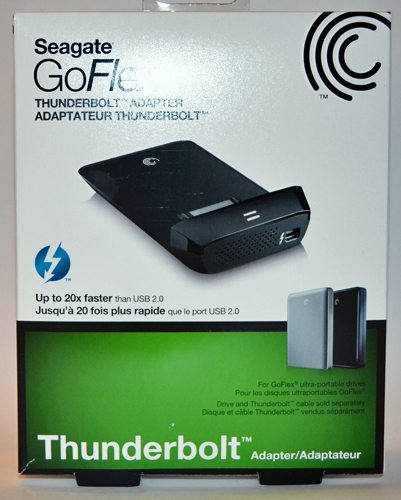 I reviewed a Seagate FreeAgent GoFlex Ultra-Portable Drive and eSATA Upgrade Cable a while ago (see related posts for a link to the review), and I’ve been using the drive since. I replaced my Dell computer with a MacBook since that review, so I can no longer use the eSATA cable with the external disk. That’s no problem, though. The beauty of the Seagate GoFlex disks is their flexibility – you can convert your external disk from USB to eSATA to Firewire 800 simply by replacing the interface cable. Although I back up my laptop everyday, I’ve recently purchased a second Seagate GoFlex disk to use as a secondary backup just for my pictures, music files, and ebooks. Even using the Firewire 800 interface cable, copying over the tens of thousands of files that I have takes a while. My MacBook Pro has a Thunderbolt connector, and I’ve been waiting anxiously for Seagate to release a GoFlex Thunderbolt adapter for the GoFlex hard drives. The wait is over!
I reviewed a Seagate FreeAgent GoFlex Ultra-Portable Drive and eSATA Upgrade Cable a while ago (see related posts for a link to the review), and I’ve been using the drive since. I replaced my Dell computer with a MacBook since that review, so I can no longer use the eSATA cable with the external disk. That’s no problem, though. The beauty of the Seagate GoFlex disks is their flexibility – you can convert your external disk from USB to eSATA to Firewire 800 simply by replacing the interface cable. Although I back up my laptop everyday, I’ve recently purchased a second Seagate GoFlex disk to use as a secondary backup just for my pictures, music files, and ebooks. Even using the Firewire 800 interface cable, copying over the tens of thousands of files that I have takes a while. My MacBook Pro has a Thunderbolt connector, and I’ve been waiting anxiously for Seagate to release a GoFlex Thunderbolt adapter for the GoFlex hard drives. The wait is over!
Most of the images in this review can be clicked for an enlargement.
First of all, what is Thunderbolt? Apple says it is “an incredibly fast input/output technology that just about anything can plug into.” Thunderbolt is based on PCI Express and DisplayPort technologies. PCI Express is built-in to all the internal components in Apple computers, so you’ll be able to connect external storage devices to your computer and get PCI Express-level performance from them. There are two I/O channels, each with 10Gbps of throughput for lightning speed. Apple quotes that you can “move data to and from peripherals up to 20 times faster than with USB 2.0 and up to 12 times faster than with FireWire 800.” Thunderbolt provides up to 10W of power to connected peripherals. You can also connect Thunderbolt video displays with these cables, but I’m not interested in that right now.
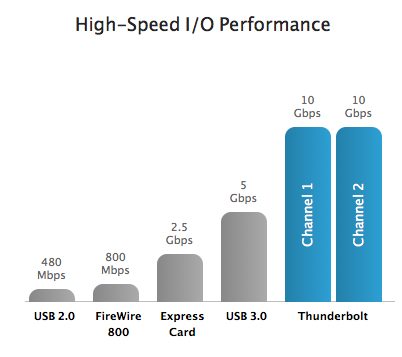
Thunderbolt also has more than enough bandwidth to allow you to daisy-chain multiple high-speed devices without needing a hub or a switch. The Seagate GoFlex Thunderbolt adapter must either be connected directly to the Thunderbolt connector on the computer or at the end of the daisy-chain.
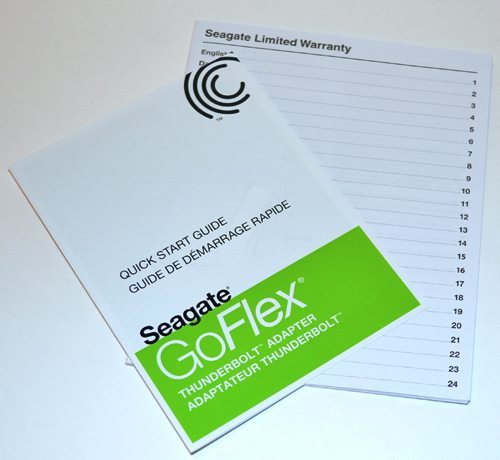 There are no accessories or cables that come with the GoFlex Thunderbolt adapter. You get only a quick start guide and a warranty booklet. It’s bus-powered, so there’s no power cable. You’ll need to provide your own Thunderbolt cable. I went to the local Apple store and picked up a Thunderbolt cable for $49. Ouch.
There are no accessories or cables that come with the GoFlex Thunderbolt adapter. You get only a quick start guide and a warranty booklet. It’s bus-powered, so there’s no power cable. You’ll need to provide your own Thunderbolt cable. I went to the local Apple store and picked up a Thunderbolt cable for $49. Ouch.
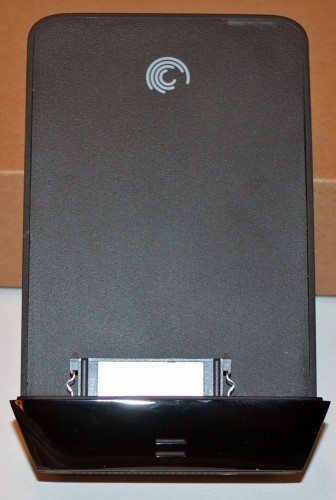 Unlike other GoFlex adapters, which consist of only a plug and a cable, the GoFlex Thunderbolt adapter looks a bit like a sledge. The end looks similar to the other GoFlex adapters with the big plug and the two power lights. It measures 4.75″ long X 3″ wide X 0.75″ tall. Surprisingly, there’s a magnet near the Seagate logo that you can see in the above picture. I’m not sure what the magnet is for.
Unlike other GoFlex adapters, which consist of only a plug and a cable, the GoFlex Thunderbolt adapter looks a bit like a sledge. The end looks similar to the other GoFlex adapters with the big plug and the two power lights. It measures 4.75″ long X 3″ wide X 0.75″ tall. Surprisingly, there’s a magnet near the Seagate logo that you can see in the above picture. I’m not sure what the magnet is for.


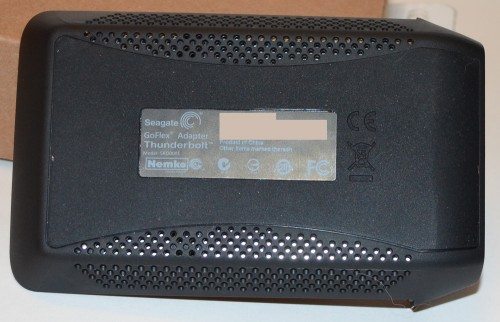 The sides and the bottom have cooling vents.
The sides and the bottom have cooling vents.
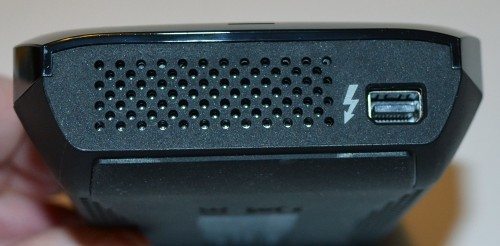 The connector end also has cooling vents. And it has a connector for the Thunderbolt cable.
The connector end also has cooling vents. And it has a connector for the Thunderbolt cable.
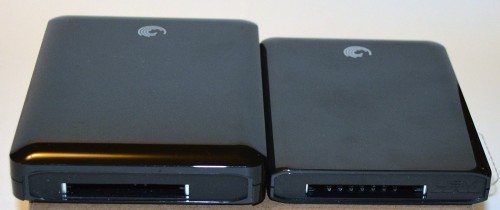
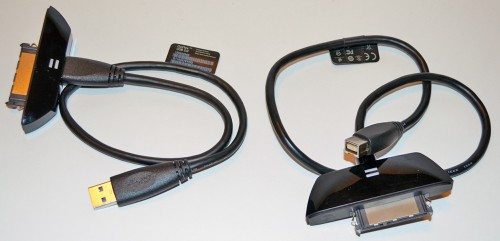 I have two Seagate FreeAgent GoFlex disks. The thicker one on the left (above) is the 1TB disk I reviewed in October, 2010. I use this 1TB disk for file transfers, temporary file storage, and the like. The thinner one on the right is a 14.5mm, thinner-profile 750GB FreeAgent GoFlex disk I bought just for my secondary backup disk.
I have two Seagate FreeAgent GoFlex disks. The thicker one on the left (above) is the 1TB disk I reviewed in October, 2010. I use this 1TB disk for file transfers, temporary file storage, and the like. The thinner one on the right is a 14.5mm, thinner-profile 750GB FreeAgent GoFlex disk I bought just for my secondary backup disk.
The second picture shows two GoFlex upgrade cables. The left one is the USB 3.0 cable that came with my new thinner-profile disk, and the right one is the Firewire 800 cable that I normally use to connect my GoFlex drives to my MacBook Pro. I also have a USB 2.0 cable that came with the 1TB disk. I actually use the USB 2.0 when I need to transfer files to other computers that don’t have Firewire. I haven’t actually used the USB 3.0 adapter, because the computers I have access to don’t have USB 3.0.
 The thinner-profile 750GB hard drive fits easily into the Thunderbolt adapter. It’s just the right thickness to fit evenly with the connector end of the adapter. I was a bit worried that the thicker 1TB disk wouldn’t fit.
The thinner-profile 750GB hard drive fits easily into the Thunderbolt adapter. It’s just the right thickness to fit evenly with the connector end of the adapter. I was a bit worried that the thicker 1TB disk wouldn’t fit.
 The placement of the connector slot on the 1TB disk allowed it to fit easily onto the connector. It doesn’t fit flush with the shape of the Thunderbolt adapter, but that’s not a problem.
The placement of the connector slot on the 1TB disk allowed it to fit easily onto the connector. It doesn’t fit flush with the shape of the Thunderbolt adapter, but that’s not a problem.
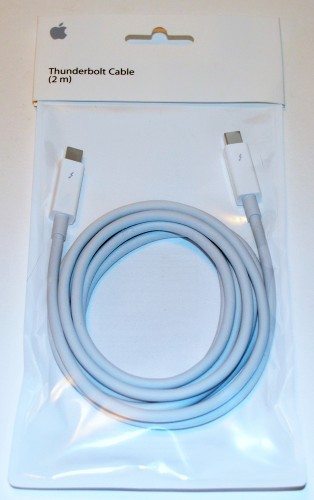
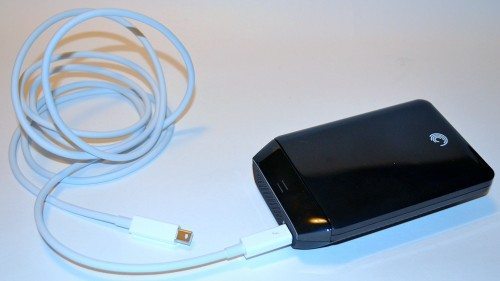 Thunderbolt cables are only available in 2m lengths. That’s too long for my needs, but there was no other option.
Thunderbolt cables are only available in 2m lengths. That’s too long for my needs, but there was no other option.
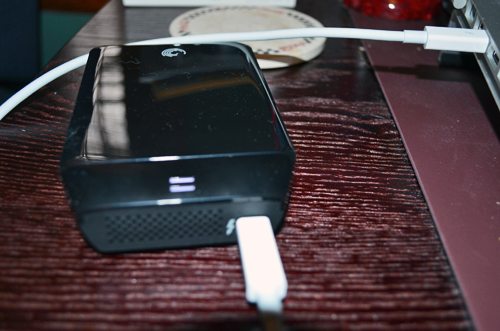 When plugged in to my laptop, the two bars light up to show the disk is ready.
When plugged in to my laptop, the two bars light up to show the disk is ready.
To test out the speed of my disk, I copied files both to and from the Seagate GoFlex 750GB disk. I copied a folder with three subfolders and a total of 457 items and 1.25GB of data. I also copied a single file that was 1.83GB in size. I tested the speed of the copies using the USB 2.0 adapter cable, the Firewire 800 cable, and the Thunderbolt adapter.
 I first tested speeds when copying from the hard drive of my laptop to the Seagate GoFlex disk with each of the connectors. The Thunderbolt adapter is significantly faster than either of the other two adapters in both tests. Speed of writing to the Seagate disk is of the most interest to me, because I’ll be doing frequent backups to the disk.
I first tested speeds when copying from the hard drive of my laptop to the Seagate GoFlex disk with each of the connectors. The Thunderbolt adapter is significantly faster than either of the other two adapters in both tests. Speed of writing to the Seagate disk is of the most interest to me, because I’ll be doing frequent backups to the disk.
 Next I tested the speeds for copying from the Seagate GoFlex disk to my laptop’s hard drive. Again, the Thunderbolt adapter is significantly faster in both tests. I’ll be able to restore my files more quickly using Thunderbolt, should I ever need to do that.
Next I tested the speeds for copying from the Seagate GoFlex disk to my laptop’s hard drive. Again, the Thunderbolt adapter is significantly faster in both tests. I’ll be able to restore my files more quickly using Thunderbolt, should I ever need to do that.

Even though I have a script that uses rsync to perform incremental backups, it took a while to complete a backup using the Firewire 800 adapter with the Seagate GoFlex disk. Now that I have the Seagate Thunderbolt adapter, I’ll be able to complete backups in less time, meaning I’m more likely to bother doing it daily now. The Seagate disk is small enough that I can throw it into my purse when I’m out of the house. I’ll know I have a recent backup of my most important files with me, even if something happens to both my laptop and my Time Capsule while I’m out of the house.
for MagSafe Wallet, Stronger Magnetic Wallet for iPhone 17/16/15/14/13/12 Series, 7 Cards Holder, Magnetic Phone Wallets, Vegan Leather Minimalist Slim RFID for iPhone Wallets, 1 Slot, Black & Black
$19.98 (as of December 3, 2025 11:39 GMT -05:00 - More infoProduct prices and availability are accurate as of the date/time indicated and are subject to change. Any price and availability information displayed on [relevant Amazon Site(s), as applicable] at the time of purchase will apply to the purchase of this product.)ESR for MagSafe Wallet with Stand, 5 Card Holder for Phone Case, RFID Blocking with MagSafe Ring, Slim Leather Magnetic Wallet for iPhone 17/16/15/14/13/12 Series(Not for Mini), Selected Samsung,Black
33% OffProduct Information
| Price: | $99.99 |
| Manufacturer: | Seagate |
| Requirements: |
|
| Pros: |
|
| Cons: |
|



Gadgeteer Comment Policy - Please read before commenting
Thanks for the write-up. We’re finally getting some Thunderbolt support now, but it’s still far too expensive for the benefits. I’ll wait until the end of the year to see what products are brought out for it.
Janet,
I thought USB 3.0 was backwards compatible with USB 2.0. You should include a USB 3.0 plug into USB 2.0 jack speed comparison. I have read that you get a speed increase using USB 3.0 devices on USB 2.0 computers. I did my own test with a USB 3.0 flash drive on USB 2.0 laptops and did not see a significant enough speed bump. I would be interested to see what results you get.
@Craig H The USB 3.0 cable worked with my USB 2.0 port, but it didn’t offer any improvement over the USB 2.0 interface cable. It was slower for both tests writing to the Seagate drive than the USB 2.0 was, and it was a bit faster in the reads from the Seagate drive, but not by much. I used the same files in my tests.
Folders to Seagate with USB 3.0 took 56.38 seconds (USB 2.0 was 46.33); large file to Seagate was 78.18 seconds (65 sec). Folders from Seagate to computer with USB 3.0 was 30.01 seconds (38.55); large file from Seagate to computer was 55.49 (57.62).
Why not include USB 3.0 (connected to USB 3.0 port) and e-SATA in the comparison? GoFlex series got these adapters.
@Alan Chan Yes, I’m aware of all the Seagate interface cables, and I actually own all the ones you mentioned. However, my MacBook Pro only has Firewire 800, Thunderbolt, and USB 2.0. I can’t test what I don’t have.
The difference in speed using the USB 3.0 cable if you don’t have a USB 3.0 port on your computer are negligible at best. It would be confusing to some people to include a “test” that makes no sense in real world applications.
USB 3.0 will become interesting when the new MacBook Pro’s and Air’s are coming out in a couple of months as part of Intel’s new Ivy Bridge chipset, which will have USB 3.0 support at the chipset level.
“The end looks similar to the other GoFlex adapters with the big, proprietary plug..”
There is nothing proprietary about that connection, it is standard SATA. You can even plug a bare 2.5″ SATA drive in to it and it will work without issue making these Seagate adapter cables great for drive cloning.
Would love to see an SSD drive plugged in to it and benchmarked copying to/from an internal SSD!
@Graham i removed the “proprietary” from the sentence. That would be a great test, if only I had the internal and external SSD drives to test! 😉
The Seagate GoFlex Thunderbolt Adapter is not ready for prime or any other time; it causes a system freeze about once per hour. Statement from Seagate support: “Thunderbolt technology is a new product from Apple, and they are aware of these types of problems and are in process of updating drivers.”.
Janet, thanks for the review. I realize I’m reviving an old discussion here… but I’m curious about the temperature of the unit considering that Seagate felt the need to include a bunch of vents.
Did it get hot during use? If so, how hot would you describe it?
Thanks!
Oh, also, did you get the sense that the magnet is there to keep the GoFlex drive in place?
Thanks again!
@Greg Singleton Yes, it did get warm during use, but the drives get warm with any of the Seagate adapter cables I’ve used – Firewire, eSATA, and USB. I haven’t noticed it getting so hot I felt like I was going to get a burn if I touched it, though.
The metal connector holds the drive snugly, so you don’t have to worry that it will come loose. I think the magnet is there to keep the other end of the disk held closely to the sledge-shaped piece. If something got pushed between the end of the drive and the Thunderbolt connector base, it could cause damage to the metal connector or to the port on the drive itself. I think the magnet holds the two ends together to help prevent things getting wedged in there.
Awesome! Thanks Janet. I appreciate the fast response on this older review!
this drive is NOT real thunderbolt speed! its limited by its eSATA interface (3gbps). this means thunderbolt, eSATA and usb 3.0 will test equivalently. see: http://www.storagereview.com/seagate_goflex_thunderbolt_adapter_review
they all max out at 80mbps read/write- which is of course much much slower than reported max’s for all! and, of course, the seagate goflex comes w usb 3.0 cables. so stick w that interface (new macbooks support 3.0). same speeds, lower price!